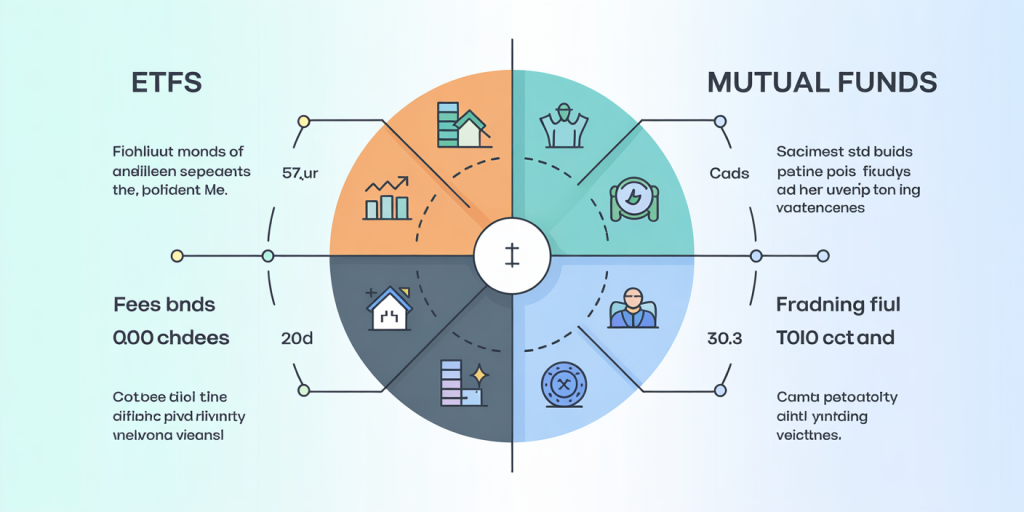ETFs vs Mutual Funds: What’s Better for Long-Term Investors?
Choosing the right investment vehicle is critical for long-term investors looking to build wealth steadily and manage risks efficiently. Exchange-Traded Funds (ETFs) and Mutual Funds have grown tremendously popular for individual and institutional investors alike. Both offer diversified exposure to stocks, bonds, or other assets, but they differ fundamentally in structure, cost, liquidity, and tax efficiency. Understanding these differences can help investors make informed decisions that align with their financial goals.


In this article, we dive deep into the nuances of ETFs and Mutual Funds, comparing their advantages and drawbacks for long-term investment horizons. Using practical examples, case studies, and data-backed analysis, we’ll offer clarity on which option might be better suited for you as a long-term investor.
—
Understanding ETFs and Mutual Funds: Basic Concepts
Exchange-Traded Funds (ETFs) are investment funds traded on stock exchanges, much like individual stocks. They typically track indexes, sectors, commodities, or themes, providing investors with easy diversification and transparency. For example, the SPDR S&P 500 ETF (ticker: SPY) tracks the S&P 500 index and trades throughout the market day at market prices.
Mutual Funds, on the other hand, pool money from multiple investors to buy a portfolio of stocks, bonds, or other securities managed by a professional fund manager. Unlike ETFs, mutual fund shares are not traded on exchanges but bought or sold at the fund’s net asset value (NAV) once daily after market close. An example is the Vanguard 500 Index Fund Admiral Shares (ticker: VFIAX), a mutual fund version of the S&P 500 index.
Both vehicles provide diversification and professional management but differ structurally. ETFs offer intraday liquidity while mutual funds operate only at end-of-day pricing. This fundamental difference shapes transaction flexibility, cost structures, and tax implications for investors.
—
Cost Efficiency: How Fees Impact Long-Term Returns
Cost is a crucial consideration for long-term investors. Over time, fees can significantly erode investment returns, making low-cost funds attractive choices. ETFs generally have lower expense ratios compared to mutual funds due to their passive management style and operational efficiencies. For instance, according to Morningstar data in 2023, the average ETF expense ratio is approximately 0.20%, while the average actively managed mutual fund charges about 0.75%.
However, investors must consider brokerage commissions when buying or selling ETFs. Although many brokers have eliminated commissions on most ETFs, some smaller or specialized ETFs might still incur trading fees. Mutual funds, particularly no-load options, can be purchased without transaction fees through fund companies or platforms.
Beyond expense ratios, mutual funds may also charge sales loads — front-end or back-end fees for buying or redeeming shares — which ETFs typically do not. These sales loads can range from 1% to 5%, significantly impacting your invested capital if you frequently contribute or withdraw funds.
| Feature | ETFs | Mutual Funds |
|---|---|---|
| Average Expense Ratio | ~0.20% | ~0.75% (actively managed) |
| Trading Commissions | Often $0 but variable | Usually $0 on direct purchase |
| Sales Loads | None | Possible (1%-5%) |
| Minimum Investment | Price of one share (~$50-$500) | Often $1,000 or more |
For long-term investors, the cumulative effect of fees can be staggering. An investor who invests $10,000 with a net 0.55% fee difference over 30 years could lose approximately $8,000 in returns, assuming an average 7% annual return on investments. Therefore, choosing the lower-cost vehicle matters immensely for compounding wealth.
—
Tax Efficiency: Maximizing After-Tax Returns
Long-term investing is about maximizing after-tax returns and minimizing tax liabilities. ETFs generally offer superior tax efficiency compared to mutual funds due to their unique creation and redemption mechanism which reduces taxable capital gains distributions.
When mutual funds need to sell securities to meet redemptions or rebalance the portfolio, they may generate capital gains that are distributed to all shareholders, resulting in a taxable event even if the investor did not sell any shares. ETFs, contrarily, use in-kind redemptions where authorized participants exchange ETF shares for underlying securities, avoiding the need to sell assets and trigger capital gains.
In practice, a study by the Investment Company Institute (ICI) revealed that ETFs distribute capital gains 30% less frequently than mutual funds on average. For example, an investor in the iShares Core S&P 500 ETF (IVV) is less likely to face unexpected capital gains taxes compared to an equivalent mutual fund, such as the Fidelity 500 Index Fund (FXAIX).
Tax efficiency becomes especially important in taxable brokerage accounts. In retirement accounts like IRAs or 401(k)s, the differences may be less relevant since taxes are deferred or minimized. However, for long-term taxable investors, ETFs can preserve more of their gains.
—
Liquidity and Trading Flexibility
ETFs provide real-time pricing and intraday trading. Investors can buy or sell ETF shares throughout the trading session at market prices, allowing tactical trades like limit orders, stop-loss orders, and intraday portfolio adjustments. This liquidity flexibility enables long-term investors to respond swiftly to market events or re-balance their portfolios efficiently.

Mutual funds, in contrast, transact only once a day after market close at the calculated NAV. This introduces a lag for executing trades and restricts intra-day price flexibility. Long-term investors who prefer a “buy and hold” strategy may find this limitation less impactful, but active portfolio management or opportunistic trading is hindered.
To illustrate, during the market volatility induced by the COVID-19 pandemic in March 2020, many ETF investors could execute trades instantly to adjust portfolios, while mutual fund investors had to wait until the day’s close, risking price uncertainty.
Liquidity can vary among ETFs as well. Highly traded ETFs like SPY or QQQ offer excellent liquidity with tight bid-ask spreads, while niche or thematic ETFs may be less liquid, affecting execution price.
—
Performance and Diversification Benefits
Performance of ETFs and mutual funds largely depends on the underlying assets and management style rather than the structure itself. Passive ETFs tracking broad indexes like the S&P 500 or the Russell 2000 have closely mirrored market performance with low tracking error.
Actively managed mutual funds have the potential for outperforming benchmarks but come with higher fees and variable track records. According to S&P Dow Jones Indices 2023 reports, about 75% of actively managed large-cap mutual funds underperformed their benchmark over a 10-year period, raising questions over their value for long-term investors.
Diversification is achievable with both vehicles. ETFs offer readily accessible exposure to niche markets, commodities, international regions, and innovative themes like clean energy or artificial intelligence through sector-specific ETFs. Mutual funds also provide diversified funds but often require minimum investments and may lack transparency in portfolio holdings compared to ETFs, which publish real-time holdings daily.
Practical example: An investor wanting exposure to emerging markets can choose the Vanguard FTSE Emerging Markets ETF (VWO) with low fees and intraday trading, or the Matthews Emerging Markets Fund (1999 inception), an actively managed mutual fund with higher fees and load charges.
—
Future Perspectives: The Investment Landscape Ahead
The evolution of investors’ needs and technology is shaping ETFs and mutual funds into increasingly sophisticated tools. ETFs are experiencing explosive growth: the global ETF market reached approximately $10 trillion in assets under management by the end of 2023, with a CAGR above 10% over the past decade (Statista, 2024). This growth is driven by innovation in smart beta, thematic investing, and fixed income ETFs, which traditionally were dominated by mutual funds.
Mutual funds, however, continue to hold significant appeal, especially in retirement plans and among investors seeking active management and personalized strategies. The future will likely see further hybrid products, such as actively managed ETFs, which combine the best aspects of both vehicles.
Regulations and tax policies may also influence investor preferences. For example, potential regulatory reforms targeting fee disclosures and transparency favor the cost-efficient and transparent ETF structure. Moreover, increased investor awareness and the rise of robo-advisors, which heavily use ETFs, point to continued ETF dominance in retail portfolios.
Long-term investors should stay informed about these trends and choose their investment vehicles based on cost, tax efficiency, flexibility, and alignment with financial objectives. Balancing these factors can lead to better wealth accumulation and risk management outcomes.
—
Selecting between ETFs and Mutual Funds is not a one-size-fits-all decision. Both have distinct advantages, and savvy investors often incorporate both depending on their needs and investment stages. Regardless, understanding the nuances of fees, taxation, liquidity, and performance helps investors leverage their investments strategically over the long haul.
